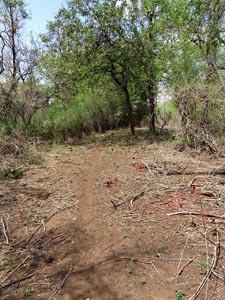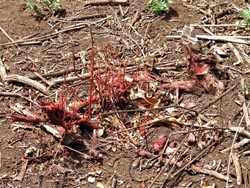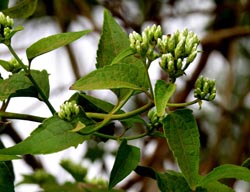PROGRAMMES: Park Management
Objectives:
The Parks Management Section is necessary in order to protect the natural fauna and flora for the benefit of present and future generations of mankind, through recreational, educational, scientific and other forms of sustainable utilisation. A vital role played by parks is the long term conservation of endangered species of flora and fauna, through the protection of their natural ecosystems. The objectives of the Parks Management Section are:
- to promote ecosystems conservation
- to promote and conserve indigenous flora and fauna and their habitats, i.e. biodiversity protection
- to promote wise use of resources outside parks (e.g. through a rationalised permit system)
- to promote conservation related tourism management of protected areas
- to eradicate non-indigenous flora and fauna from protected areas and to prevent new invasions to collect together and restore to the park or reserve a representative selection of the plants and animals which are indigenous, or are reasonably considered to have been indigenous, to the area
- to protect and preserve or to restore objects of archaeological, historical and cultural value in the protected area
- to provide facilities for scientific study to provide facilities for education (interpretation)
- to promote public appreciation of the social, economic and aesthetic value of nature conservation
- to facilitate sustainable resource utilisation within the protected area
- without compromising the foregoing objectives, to provide enjoyment to visitors to the park or reserve
- without compromising the foregoing objectives, to generate revenue
Reserve Specific Policy
Introductions
The policy with regard to introductions of fauna or flora is that for all potential introductions the following factors must be carefully considered:
- Genetic composition of donor population, and genetic composition of any existing (in the reserve) populations of that species.
- Habitat requirements of the species, size and distribution of this habitat type in the reserve.
- Effects of this species on its habitat.
- Effects on any existing (in the reserve) populations of this species.
- Effects on other species through competition, predation or other indirect effects.
- Will the population to be introduced be viable in the long term?
- Will the introduced animals cause unacceptable problems to neighbours?
If any of the above factors indicate that such introductions could be detrimental to the reserve, the introduction should not be carried out.
Management of Vegetation
In order to maintain the high biodiversity in the reserve, the area should be managed as part of a dynamic ecosystem. Management activities should not aim to try to keep the reserve in a static state.
Culling
The policy with regard to culling in the reserve is that culling should be carried out for two reasons, firstly, when there are ecological grounds for reducing the population size of the species, and secondly, in order to promote good neighbour relations through provision of affordable meat.
Mlawula Reserve Management
(Contributed by Ngwane Dlamini, Senior Warden, Mlawula)
Culling
Culling is done on the basis of the population estimates as per the recommendations of SNTC ecologist and is usually staggered all year round.
The challenges here are to conduct the culling operation without interfering with the on going park tourism initiatives; avoiding vehicle shyness of the animals to promote game viewing; and totally avoid noise from the rifle from tourists and signs of the operation.
Culling is normally done at night at specific sights of the park. Most appropriate done when there are no visitors in the park, with a low noise caliber of rifle such a point .22 or .223.
Fire Protection and Management
The park occasionally encounters some fires coming from its neighboring communities. Other fires are started internally deliberatively some by poachers. Sometimes we encounter natural fires cause by lighting. Management focus on protecting its building and other properties by at annual basis establishing protective fire breaks round each the leaving compounds, offices and weather station.
On the use of fire as a management tool, we have managed to strategically create some block burns. This are normally created early in the dry season to prevent to encourage reduced intensity and are repeated once in every four years.
We still have a great concern for the uncontrolled fires, which happens every year across the Ndzandza Mahlabashane mountains.
Alien Plant Control

The reserve has 3 most problematic alien species namely Parthenium hysterophorus, Chromolaena odorata and Lantana camara. Though not adequately controlled, much focus has been given Chromolaeana odorata due to national influence. Apart from these species there is a total of over 50 different species that are considered alien plants in the reserve. Chromolaena alone has been recorded as affecting a total of 35% of the total park area.


There is an ongoing programme of cutting and burning to control alien plants.
Challenges associated with this programme include inadequate budget for the purchase of herbicides, insufficient manpower, inadequate equipment (picks, bush knives, slashers), insufficient alien plant research, and a lack of policy with regard to invasive species prevention and control measures.
Park Maintenance
Routine park maintenance activities are carried out by 8 staff members, and include road repairs and maintenance, building and plumbing repairs and maintenance, and alien plant control.
Law Enforcement
Upon realizing that the rate of poaching has always been increasing in recent years the reserve adopted the following strategies:
- Re-introduction of a double punishment program; the culprit once court face the court of law and latter is charged by his/her traditional leader/chief.
- Meat is made available to the local communities when it has been requested.
- Meat is sometimes sold at the office in pieces that are thought to be affordable to most people. Some times these meat piece is taken to the reserve borders nearest to the communities.
- More community engagement in park conservation programs and workshops are facilitated through the Community out reach programs.
- Where appropriate communities are encouraged and assisted to establish their own game ranch facility.
Animals targeted by the poachers are impala, wildebeest, kudu and warthogs. They on rare occasion go for Nyala, bushbucks, zebras and other species. A couple of poachers were caught for cutting ironwood poles and were all residents of Mozambique, when asked why they were cutting they all indicated they wanted them for making coal.

